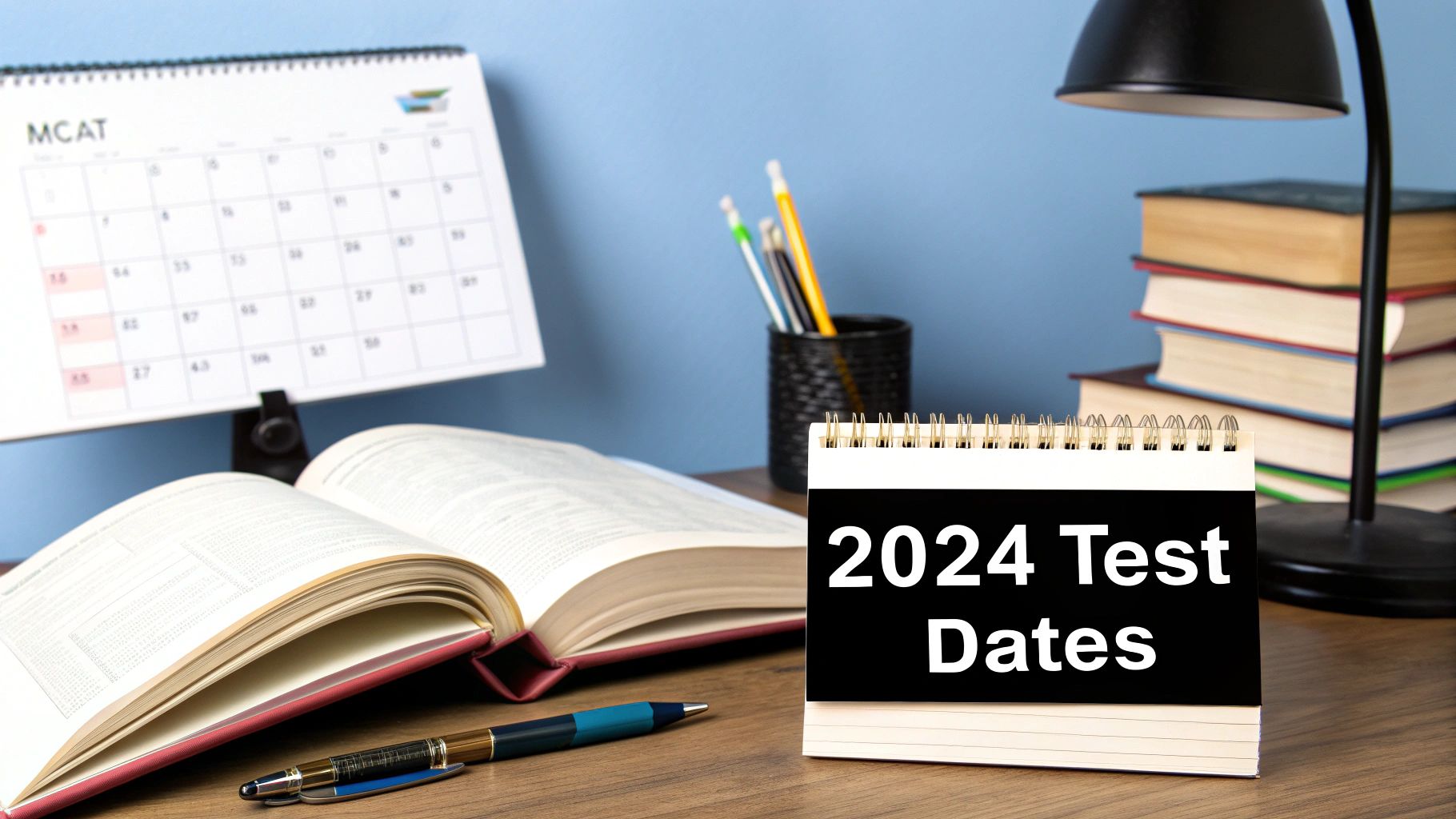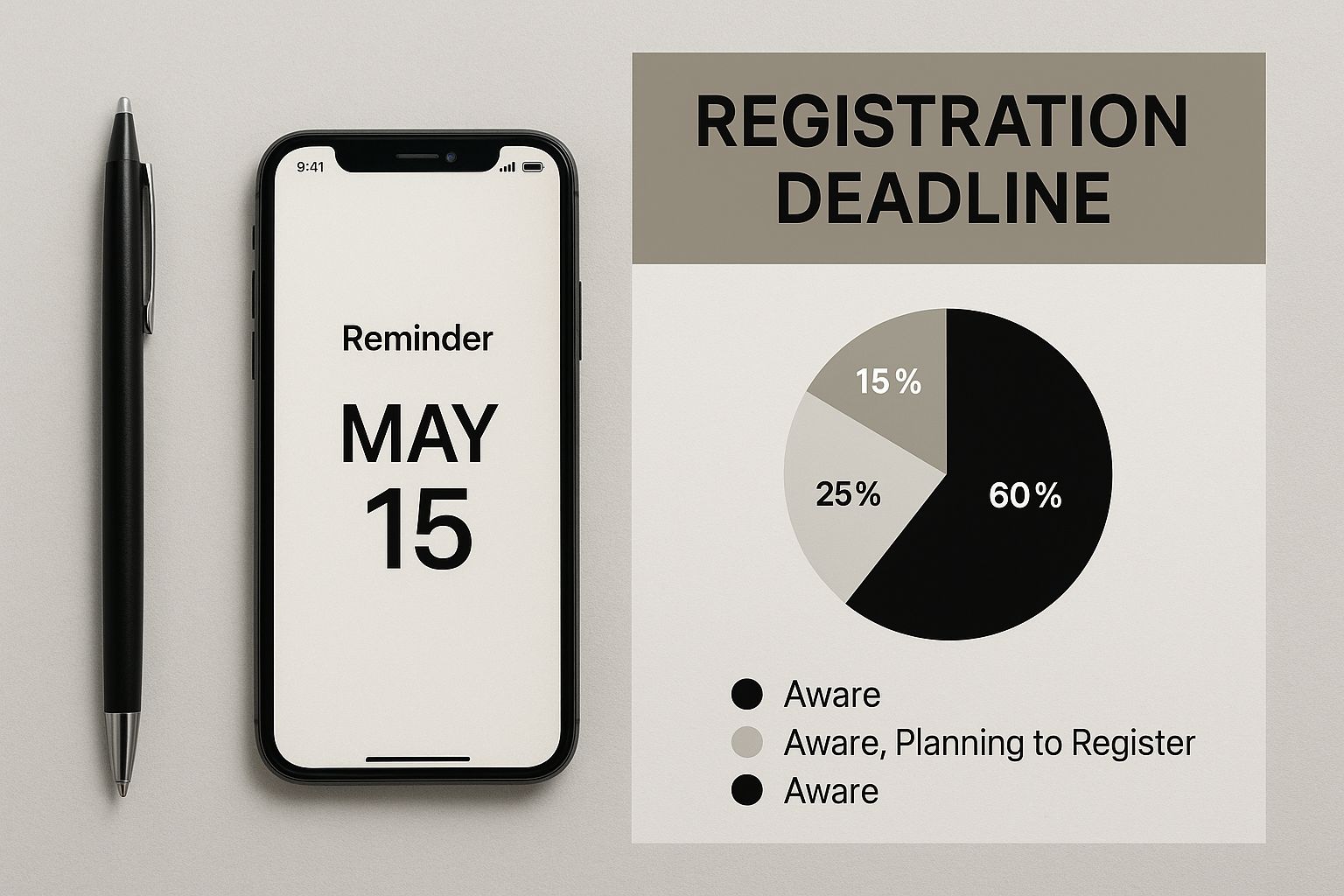The official MCAT test dates are always concentrated between January and September each year. This schedule gives prospective medical students plenty of opportunities to find a date that works for them.
Keep in mind that registration is also split. Sign-ups for the first half of the year (January-June) typically open in October, while registration for the back half of the year (July-September) usually opens in February.
Understanding the MCAT Testing Year

Planning your MCAT journey requires looking at the entire testing year as a whole. It’s not just a single event; think of it as a repeating cycle with distinct phases that give you flexibility in your prep. The real key is to visualize this timeline so you can pick a test date that lines up perfectly with your study plan and application deadlines.
It wasn't always this way. Years ago, the exam was only offered a handful of times annually. Today, with over 30 test dates available, the AAMC has made the test much more accessible for the growing number of applicants. This modern schedule allows for some serious strategic planning, including building in time for a potential retake if you need one.
This section will give you a high-level overview to help you strategically map out your path. It all boils down to a few main phases.
The MCAT calendar can feel complicated, but breaking it down into its core components makes it much more manageable. To help you visualize your prep timeline, we've put together a table that outlines the key phases of a typical testing year.
The MCAT Testing Year at a Glance
| Phase | Typical Timeframe | Key Action |
|---|---|---|
| Early Registration Opens | October | Sign up for test dates in the first half of the year (January-June). |
| Late Registration Opens | February | Sign up for test dates in the second half of the year (July-September). |
| Testing Season | January – September | The primary window when the MCAT exam is administered. |
| Score Release | ~30-35 Days Post-Test | Results are released, a critical date for application planning. |
By understanding these key periods—registration opening, the main testing season, and when you can expect your score—you can build a realistic and effective preparation timeline that sets you up for success. It's all about working backward from your application deadlines.
Official MCAT Test Date Calendar
Choosing your MCAT test date is one of the first major strategic decisions you'll make on your path to medical school. It’s not just about finding a day that works; it's about building a timeline that gives you enough breathing room for prep, potential retakes, and hitting those all-important application deadlines.
The AAMC typically offers more than 30 MCAT test dates each year, concentrated between January and September. This gives you plenty of options to align the exam with your study plan. A well-chosen date means you can prepare thoroughly without the last-minute panic, and maybe even leave a window open for a second attempt before your primary applications are due.
Why Every Deadline Matters
This isn't just about the final registration deadline. The AAMC uses a tiered "zone" system—Gold, Silver, and Bronze—each with its own deadlines for scheduling, rescheduling, and canceling. Missing one can have a ripple effect on your entire application cycle.

Think of these deadlines as non-negotiable. Pinning your chosen date and its associated deadlines on your calendar is a critical first step. Slipping up on registration could mean having to settle for a much later, less ideal test date.
Official MCAT Test Date and Registration Deadline Calendar
To make your planning easier, we’ve put together a comprehensive table with all the upcoming test dates. It includes the key deadlines for the Gold and Bronze zones, plus the all-important score release dates. Use this to map out your study schedule and lock in your target test day.
| Test Date | Registration Deadline (Bronze Zone) | Final Deadline (Gold Zone) | Score Release Date |
|---|---|---|---|
| Jan 12, 2025 | Jan 2, 2025 | Nov 28, 2024 | Feb 13, 2025 |
| Jan 18, 2025 | Jan 8, 2025 | Dec 4, 2024 | Feb 20, 2025 |
| Mar 14, 2025 | Mar 4, 2025 | Jan 28, 2025 | Apr 15, 2025 |
| Mar 28, 2025 | Mar 18, 2025 | Feb 11, 2025 | Apr 29, 2025 |
| Apr 12, 2025 | Apr 2, 2025 | Feb 26, 2025 | May 13, 2025 |
| Apr 26, 2025 | Apr 16, 2025 | Mar 12, 2025 | May 28, 2025 |
| May 16, 2025 | May 6, 2025 | Apr 1, 2025 | Jun 17, 2025 |
Note: All deadlines are at 11:59 p.m. local test center time on the day of the deadline.
Once you’ve identified a few potential dates, your next move should be to head over to the AAMC website to confirm availability in your area. Seats can fill up fast, especially for popular spring and early summer dates, so it's wise to register as soon as you're confident in your timeline.
How to Strategically Choose Your MCAT Test Date

Picking your MCAT test date is one of the first major strategic decisions you'll make on your path to medical school. It's so much more than just finding an open Saturday—it's about building a timeline that sets you up for success, not a last-minute scramble. The right date gives you enough breathing room to study thoroughly without slamming you up against your primary application deadlines.
It all comes down to a balancing act. You have to weigh your current academic schedule, the raw number of hours you can realistically dedicate to MCAT prep, and the application cycles of your target schools. One of the biggest mistakes I see students make is underestimating just how much content the MCAT covers. You need a solid plan.
Assess Your Study Timeline Realistically
Before you even look at the calendar, you need to get brutally honest with yourself about your commitments. How many hours a week can you actually set aside for studying? Most experts agree you'll need around 300-350 total study hours to truly master the material and feel confident on test day.
Let's break down a few common timelines to see where you might fit:
The Early Bird (March/April Test): This is a fantastic option if you want a safety net. Testing in the early spring means you get your score back with plenty of time to assess, and if you need to retake, you can do so before primary applications are due in June. It takes a lot of the pressure off.
The Classic Planner (May/June Test): This is probably the most popular route. It allows you to use your winter break and the spring semester to buckle down and study hard. This timing syncs up perfectly with the application cycle, so your scores are ready to go right when you need them.
The Marathoner (July/August Test): If your spring semester is packed or you still have some prerequisite courses to wrap up, this timeline gives you the maximum amount of prep time. The major trade-off? It leaves virtually no room for a retake within the same application cycle, which can be a risky move.
A thoughtful and well-structured study schedule is the single most important tool in your MCAT preparation. It serves as your roadmap and accountability tracker, and students who create a solid plan tend to perform significantly better on the exam.
Ultimately, your goal is to map out a personalized timeline that plays to your strengths and accounts for your life's realities. If you're looking for a solid framework to get started, this detailed MCAT study plan is a great resource for structuring your content review and practice phases.
https://acemedboards.com/mcat-study-plan/
Navigating MCAT Registration and Scheduling Zones
Alright, so you've decided on an MCAT test date. Getting it locked in through the AAMC portal is your first real step, but it's not as simple as just picking a day on the calendar. The process involves a tiered system that has a direct impact on your flexibility and, more importantly, your wallet.
The AAMC has set up three scheduling zones—Gold, Silver, and Bronze. Think of them as time windows leading up to your test date. Each zone has its own set of deadlines and fees for rescheduling or canceling your exam. A little bit of planning here goes a long way, as making any changes inside the Gold Zone will save you the most money.
Understanding the Zone Deadlines
These zones are essentially deadlines that dictate how much it'll cost you to change your plans. The closer you get to your test date, the more expensive it becomes.
- Gold Zone: This is your best-friend zone. It’s the earliest window, and it closes 30 days before your exam. Any changes you make here are the most affordable.
- Silver Zone: This is the middle ground. The Silver Zone window closes 15 days before your exam. Fees start to jump up pretty significantly here.
- Bronze Zone: This is the last-chance saloon. This window closes just 8 days before your exam. Not only are the fees highest in this zone, but you also lose the option to cancel for any kind of refund.
Let’s put this into perspective. If you need to reschedule, the fee might be a manageable $50 in the Gold Zone. Wait until the Bronze Zone, and that same change could cost you $200. That $150 difference is exactly why locking in your MCAT plans well in advance is a smart move.
The AAMC's zone system is really designed to encourage you to plan ahead. By registering for your preferred date as early as possible, you give yourself the longest possible amount of time in the Gold Zone. This buys you maximum flexibility at the lowest cost if your study timeline suddenly needs to shift.
Ultimately, being proactive does more than just secure your spot—it acts as a financial safety net against expensive, last-minute changes. It's always a good idea to double-check the official AAMC fee schedule for the most current pricing.
Understanding MCAT Score Release Timelines
The wait after taking your MCAT can feel like the longest month of your life. Thankfully, the AAMC doesn’t leave you guessing forever. They have a standardized process for releasing scores, which typically become available 30-35 days after your test date. This timeline is consistent across all MCAT test dates, so everyone is on a level playing field.
Why does this wait matter so much? It's a critical period for mapping out your application strategy. Getting your score back with plenty of time before primary application deadlines lets you decide if a retake is the right move for you. You'll get an email notification as soon as your score is ready, and you can view your official report by logging into the AAMC Score Reporting System.
How Your Score Fits into the Big Picture
Your total score is a major piece of the admissions puzzle. The MCAT score scale runs from 472 to 528, with the mean score for each of the four sections hovering somewhere between 125.0 and 126.1. Data from May 2015 through April 2025 shows that the average section score has remained remarkably stable, fluctuating only slightly from 125.1 to around 125.9. This tells you the competitive bar for applicants has been pretty consistent over the years. For more deep dives into score statistics, you can often find good breakdowns on sites like BestColleges.com.
Keep this in mind: Knowing the score release calendar is just as important as picking your test date. A score that comes in too late can throw a wrench in your entire application plan, potentially pushing back your submission to medical schools.
Once your score is in hand, the next step is figuring out what it means. If you're wondering how your results stack up against the competition, check out our guide on what is a good MCAT score. This will help you put your performance in context with your target medical schools and figure out your next steps.
A Look Into the MCAT's History and Evolution
To really get a handle on the modern MCAT, it helps to look back at its nearly 100-year journey. The exam's story isn't just a list of dates; it shows a massive shift in what it means to be a doctor, moving from pure knowledge recall to the sophisticated critical thinking and problem-solving skills today's physicians need. Understanding this history explains exactly why certain MCAT test dates are so competitive and why the test is built the way it is.
Believe it or not, the Medical College Admission Test first showed up back in 1928. It was called the “Moss Test” and was a simple true/false exam checking scientific jargon, memory, and reading skills. Even so, its impact was huge. It helped standardize what pre-meds were learning and slashed medical student dropout rates from a staggering 50% in the 1920s to just 7% by 1946. You can dive deeper into this critical moment for medical school admissions in this historical overview.
Over the decades, the MCAT has gone through several major makeovers. With each revision, the test moved further away from rewarding rote memorization and closer to assessing the analytical chops essential for a career in medicine. This evolution is what makes the MCAT a relevant and reliable predictor of a student's ability to thrive in the demanding world of medical school.
Frequently Asked Questions About MCAT Dates
Figuring out the logistics of MCAT test dates can feel like a puzzle. Let's tackle some of the most common questions head-on so you can schedule your exam with confidence and sidestep any registration headaches.
How Far in Advance Should I Register for the MCAT?
The short answer: as early as you possibly can. I recommend trying to register the very day that registration opens for your testing window. Popular dates and prime locations, especially in the spring and early summer, can fill up in a matter of hours.
As a rule of thumb, always aim to register at least 60 days before your target exam date. This gets you into what the AAMC calls the "Gold Zone," giving you the most flexibility and the lowest fees if you need to reschedule or cancel. Life happens, and having that option without a hefty penalty is a huge relief.
What Are the Limits on Taking the MCAT?
Yes, the AAMC has strict limits on how many times you can sit for the MCAT. It’s crucial to know these rules before you map out your testing strategy.
- You can take the exam a maximum of three times in a single testing year.
- You are limited to four attempts within any two-consecutive-year period.
- There is a lifetime limit of seven total attempts.
Remember, medical schools see all of your scores, so every attempt counts. Your goal should be to make each one your best effort. If you're considering a retake, it's vital to understand how to improve your MCAT score with a focused and strategic approach.
What if My Preferred Test Center Is Full?
Don't panic if your first-choice center is full. The first thing you should do is check for availability at other nearby locations. Sometimes, a slightly longer commute is all it takes to find an open seat.
Your next step is to sign up for the AAMC’s email notification system. This tool is a lifesaver—it automatically alerts you if a spot opens up at your preferred center because another student canceled. Seats free up more often than you'd think, especially as the test date gets closer, so being vigilant can really pay off.
At Ace Med Boards, we provide expert, one-on-one tutoring to help you master the MCAT and achieve your target score. Start your journey with a free consultation and build a personalized prep plan that fits your needs. Find out more at https://acemedboards.com.
